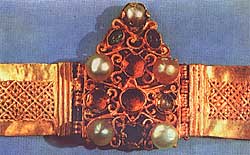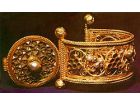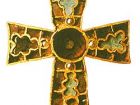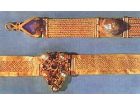THE VARNA TREASURE - THE TOILET OF A BYZANTINE NOBLE LADY
THE VARNA TREASURE
THE TOILET OF A BYZANTINE NOBLE LADY
THE TOILET OF A BYZANTINE NOBLE LADY
In the hot month of July 1961 started the building of an open cinema in Varna. In the first days of the digging students discovered at a depth of 1.50 m several gold objects. They immediately took them to the Varna Historical Museum, which made its research. Scholars decided that this was female jewelry buried in the ground probably in a bag of cloth. When this happened could not be immediately determined but the place of the find was beyond the limits of the ancient town of Odesos and there were no traces of buildings around. The find is at 500 m off the fortress wall and belongs generally to the early Byzantine period.
The treasure found consists of 9 items weighing 417 g. These are two massive bracelets, a diadem, parts of three necklaces, a cross and two belt applications. All are made of pure gold (over 22 carats). Undoubtedly most interesting are the two bracelets, weighing about 220 g or half of the whole find. Despite some differences they are similar in make and ornamentation. They consist of two semicircular pats, connected with a hinge. They are decorated with ornaments of plants: a vine twig with leaves and grapes. In the ads.
The diadem (fully preserved) represents two strips connected again by a hinge. On them there are filigreed rhombs, cross-like figures, palmetes and pearls.
The three necklaces are partly preserved. There are only three parts of the twisted wire preserved from one of them. From the second one are preserved 5 pieces, and from the third we have a large number of cylindrical beads. The three necklaces are ornamented with pearls or glass-like paste.
Greatest interest is presented by the cross-made of gold plates, which make beds for the implantation of inlays of malachite and garnet in the form of stylized plants. This is the so-called cell technique in jewelry, widely used in the first half of the 1-st millennium AD.
The belt applications are very similar in make to the cross. They also have stylized plant ornaments of malachite, garnets and pearl inlays.
The overall look of the treasure leaves no doubt that it represents a set of jewelry belonging to a prominent representative of the early Byzantine community in Odesos. In their production were masterfully used various goldsmith's techniques - molding and hammering of the gold plates, inlays of pearls, precious stones, glass and enamel. The jewelers also used filigreed ornaments, granulation and engravings, which demonstrates an unbelievable for its time mastery in jewelry. Similar goldsmith's techniques (the hinging technique, for example) are mostly characteristic of the 4th-5th c. AD. Analogical finds allow dating it around the beginning of the 6th c.

The beginning of Christianity is expressed in the numerous cross-like ornaments and most of all in the small cross itself, which has analogical examples from the same period. The rich though strongly stylized plant ornamentation is a symbolic expression of Heaven and also finds application in monuments of various nature. To strengthen this concept masters used colour variety: the green colour of the leaves, the white beads of the grapes, and the brown and purple tones of the surrounding flat surfaces. The form of the crosses can be seen in some monumental finds like the mosaics in the church of San Vitale (the period of Justinian) or in the Saint Apolinario Nuovo church in Ravenna, in Rome and other cities.
The jewelry from Varna is no doubt the product of masterful goldsmiths.
The elements of crudeness in comparison with find from the Hellenic or the Roman period are compensated for by the colour diversity of the materials used.
We can't expect that the treasure have been imported into the town.
More probably it is the product of the Odesos School of jewelry making.
This is also a proof of the prosperity of the town in the first half of the 6th c. It must have been buried into the ground in difficult times.
Most probably these were the more and more numerous Barbaric attacks on the Empire.







